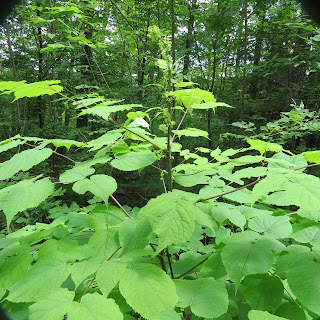Charlotte Lake, Renfrew County, Ontario July 2017 #3
What a biologically/ecodiverse/splendiferous region I live in. These qualities caused me to join the Board of Directors of the Mississippi Madawaska Land Trust that purchases and creates easement agreements with landowners in the titled watersheds. Yes my American friends, Canada has its own Mississippi River.
The various land-forming processes (glaciers, huge rivers and even a salt water sea) have given shape to the surroundings, with a variety of wet/rich and not-so-rich habitats. This results in one of the most diverse collections of Odonate species (dragonflies and damselflies) on our continent.
Red Columbine, Aquilegia canadensis. This lovely wild flower grows, sometimes in large numbers, around wettish areas in the Ottawa Valley. If you get a chance, find a local grower and add it to your garden. What a splash of colour and form!
Spreading Dogbane, Apocynum androsaemifolium, note recurved lobes, distinguishes from Intermediate A. medium. Compare to Indian Hemp and Intermediate Dogbane.
I need to take better notes! I mis-identified this uncommon plant (above) in a previous version of this edition. This is not the common Cornus rugosa (which I like very much!). It is the very UNcommon Aralia racemosa, or Spikenard. Spikenard is a very large round-leaved relative of the very common Aralia nudicaulis, or Sarsapirilla. You may have heard of a soft drink called Sarsapirilla, mispronounced in the US, sometimes, as Saspirilla. Strangely, the soft drink is not made from this plant! It is derived from Smilax ornata, a very different unrelated plant.
Both Aralia plants are in the Ginseng family. The size, leaves and cluster of flowers just emerging at the top of the plant are all indicative.
As seen in the last blog, ferns are abundant around Charlotte Lake. The Wood Ferns are the most frequently found ferns in rich forests locally, and they are very difficult to tell apart. This one (above) is the most elegant of the Wood Ferns. Pinnae are cut and cut again. The fronds are very long and rich coloured this time of the year. They arise from a central point. Pinnae are longest at the middle, and almost disappear towards the narrowing tip. This is Lady Fern, Athyrium filix-femina.
My fingers are clutching one of the newly developed fertile fronds which will bear spores later in the summer.
A favourite woodland maroon 6-petaled flower (April-May), Blue Cohosh, Caulophyllum thalictroides, is shown above. The flowers have already been replaced by developing fruits, which do turn a spectacular blue. Caution: these pretty fruits are poisonous.
For the bird-lovers, the sequence which begins with the above photo and continues below is, likely, a once in a lifetime opportunity which most of you may never experience. I was very fortunate to spot this newly fledged Blue-headed Vireo (used to be called Solitary Vireo for you older people!), Vireo solitarius.
An adult, on the left has arrived to feed the fledgling. Note the young bird is spreading its new wings. Mom or Pop turns briefly and lets out a call, perhaps signalling to the other parent.
More ferns! This one named itself when I looked on the underside of the fertile frond. The sori (the spore-containing bodies which appear as roundish and lighter than the pinnae above) are just developing on this Marginal Wood Fern, Dryopteris marginalis. And below, a more mature Lady Fern on my knee. Note the longer pinnae in the middle of the frond, and shorter ones toward the base..
The plant above with maple-leaf shaped leaves, and a large purple flower is Flowering Raspberry, Rubus odoratus. These are also very common in our Eastern Ontario woods. The berries do look like very large raspberries. These are only palatable to wildlife, so don't be trying one!
Back we go to the trials of fern identification. This is a big fern, as you are able to see my fern field guide in the photo above for size comparison. Note that the fronds emanate from a common point in the centre. Below, you see mature sori (which are the dark spots, and the are not at the margin, but rather clustered along the mid veins of the pinnae. So it is not Marginal Wood Fern, but it does look like another of the Wood Ferns.
Note that, like the Lady Fern, the pinnules are toothed, though not as delicately as in Lady Fern. Also, the longest pinnae are not at the centre of the frond. Note also that the stipe (lower leafless stem of each frond) is hairy and scaly.
I had not encountered this very large wood fern before, and I took home a piece of a frond to help with the identification. It is now dried within the pages of my fern field guide. Even though it is more than a year since I collected the specimen, it rests within the field guide at the page for Goldie's Fern, Dryopteris goldiana. After review at my desk, I am sticking to this identification!
Flowers and new creatures when we return for instalment 4 of Charlotte Lake soon!

















No comments:
Post a Comment
Help with "Comments"
1) Click on "Comments" at the end of the blog entry that you wish to comment on.
2) Type your comment in the field provided.
3) Under your comment choose "Name/URL". Type your name (first and/or last names) in the box provided. Choosing "Name/URL" will ensure that you do not need to "register" before leaving a comment.
4) Click "Preview" to see how your comment will look on the site if you wish, otherwise skip to step 5.
5) Click "Publish" to submit your comment.
Please note that all comments are moderated so I will review them before they are published.
I look forward to receiving your comments.